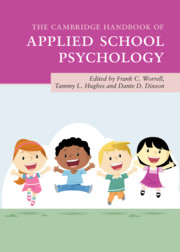Book contents
- The Cambridge Handbook of Applied School Psychology
- The Cambridge Handbook of Applied School Psychology
- Copyright page
- Contents
- Contributors
- Contributor Biographies
- Acknowledgments
- 1 Broadening the Focus of School Psychology Practice
- Part I Individual-Level Academic Interventions
- Part II Teacher- and System-Level Interventions
- Part III Interventions from Educational and Social/Personality Psychology
- 10 Belonging in Schools: A Social Psychological Perspective
- 11 Cross-Race/Ethnic Friendships in School
- 12 Self-Regulated Learning in School Contexts
- 13 School Environments that Facilitate Delaying Gratification
- 14 Understanding and Cultivating Hope in School
- 15 School Settings that Facilitate High Teacher Expectations
- 16 Parental Autonomy and Relatedness Support
- 17 Preventing and Minimizing Stereotype Threat in School Settings
- 18 The Hidden Classroom: How Gender Stereotypes Impact Academic Achievement
- Part IV Behavioral and Social-Emotional Interventions
- Part V Health and Pediatric Interventions
- Part VI Family Connections and Life Transitions
- Part VII Special Populations
- Part VIII Conclusion
- Index
- References
14 - Understanding and Cultivating Hope in School
from Part III - Interventions from Educational and Social/Personality Psychology
Published online by Cambridge University Press: 18 September 2020
- The Cambridge Handbook of Applied School Psychology
- The Cambridge Handbook of Applied School Psychology
- Copyright page
- Contents
- Contributors
- Contributor Biographies
- Acknowledgments
- 1 Broadening the Focus of School Psychology Practice
- Part I Individual-Level Academic Interventions
- Part II Teacher- and System-Level Interventions
- Part III Interventions from Educational and Social/Personality Psychology
- 10 Belonging in Schools: A Social Psychological Perspective
- 11 Cross-Race/Ethnic Friendships in School
- 12 Self-Regulated Learning in School Contexts
- 13 School Environments that Facilitate Delaying Gratification
- 14 Understanding and Cultivating Hope in School
- 15 School Settings that Facilitate High Teacher Expectations
- 16 Parental Autonomy and Relatedness Support
- 17 Preventing and Minimizing Stereotype Threat in School Settings
- 18 The Hidden Classroom: How Gender Stereotypes Impact Academic Achievement
- Part IV Behavioral and Social-Emotional Interventions
- Part V Health and Pediatric Interventions
- Part VI Family Connections and Life Transitions
- Part VII Special Populations
- Part VIII Conclusion
- Index
- References
Summary
A student’s hope – their ability to both envision paths to desirable future goals and believe that they will get there – is a powerful force within the school context. In this chapter, I discuss the relevance and utility of hope within the school setting for school psychologists. The chapter begins with an overview of hope theory, including how it is typically measured and its documented relationships with the achievement, academic engagement, mental health, and socioemotional functioning of students. Next, I discuss several ways school psychologists can promote hope schoolwide through various school policies and actions. Lastly, I go over several research-based hope interventions that can be employed in small groups as well as several informal hope-based interventions that can be utilized by school personnel more broadly. There are many ways that hope can be useful to school psychologists. This chapter provides a starter hope toolkit for how it can be leveraged.
- Type
- Chapter
- Information
- The Cambridge Handbook of Applied School Psychology , pp. 224 - 238Publisher: Cambridge University PressPrint publication year: 2020



